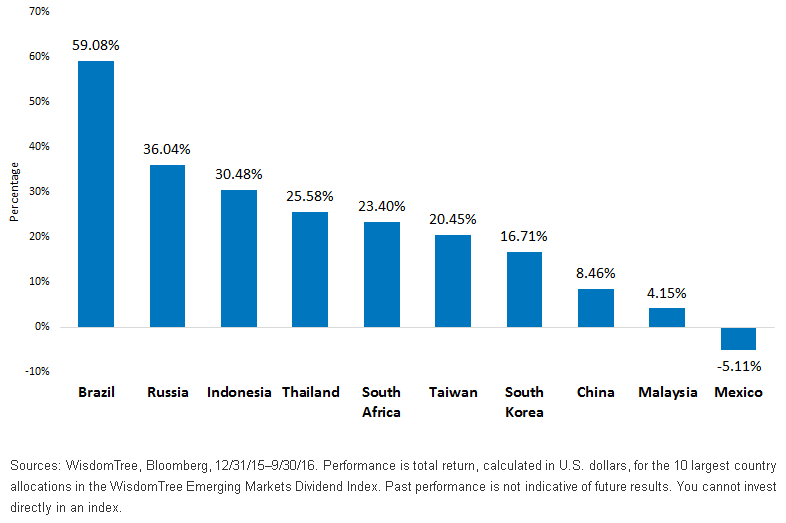Rebalancing Back to Valuations in Emerging Markets



After a painful three to five years, emerging markets (EM) have been roaring back in 2016 and leading regional performance. The gains began with stability in oil prices in February and the Federal Reserve (Fed) not hiking interest rates, providing support for emerging market currencies and asset prices. But these gains continued in the third quarter on China’s fiscal expansion spending.
Looking across all of WisdomTree’s Indexes covering the global markets, the single best performing Index of more than 70 equity strategies for WisdomTree in the third quarter was a China-focused Index, the WisdomTree China Ex-State-Owned Enterprises Index, signaling renewed market confidence in Chinese equities and a view that China would avoid a “hard landing” in its economy on stepped-up government spending.
There has been a wide cross-section in performance across emerging markets. Below we chart the performance of the 10 largest countries in the WisdomTree Emerging Markets Dividend Index over the last year.
WisdomTree Emerging Markets Dividend Index: Country Performance (12/31/15–9/30/16)

Commodity Exporters Lead the Pack
At the top of the performance list was Brazil, which saw large gains in both its equity market and its currency. This was followed by Russia, Indonesia and South Africa soon after. Something these countries all have in common is their connection to commodity prices and exports—following years of subdued and negative expectations, stability in commodities led to a strong rebound in all these markets and their currencies.1
WisdomTree’s best performing emerging market strategy in 2016 has been a high-dividend, value-seeking strategy, the WisdomTree Emerging Markets High Dividend Index. 2
This Index has been over-weight Energy and Materials for the last few years, when it started identifying high-dividend-yielding stocks in these sectors at the 2012 rebalance, particularly those with an emphasis on Russian exposure.
While the market cap-weighted MSCI Emerging Markets Index saw its weight in commodity sectors (Energy and Materials) cut in half—from 29% in September 30, 2009, to 14% on September 30, 2016—the WisdomTree Index actually added to its exposure from its lows in 2010 and 2011. Going in to this year’s rebalance, it had more than 30% exposure to those two sectors.
The Fundamental Difference: Rebalancing
This is a big difference between a cap-weighted index—which rides momentum of stocks to higher and lower weights—and a dividend-weighted and high-yield screened index that is designed to identify opportunities based on changes in relative valuations.
Commodity-oriented sectors and countries have been strong market performers in 2016, and the gains are coming at levels greater than changes in the underlying fundamentals of companies, as measured by their Dividend Streams® in U.S. dollars.
WisdomTree just announced its latest Index constituents, and following the close of trading on October 20, the WisdomTree emerging market Indexes rebalanced into new holdings and weights. From the annual screening date, the Index reduced weight in the commodity sectors by more than 5 percentage points while increasing exposure in Telecommunications and Utilities stocks by a similar total in aggregate.
Brazil is a reflection of this, as its gains were far and above any other country, and Brazil exposure was reduced by more than 5 percentage points. South Korea, Taiwan and Turkey were the biggest recipients of added weight.
The rebalancing process here essentially took some chips off the table from the gains in Brazil, and the Index is taking a bit more of a defensive posture after the rebalance. However, we should note that despite lowering weight, the Index still has more than 25% of its exposure to commodity sectors, and that is still significantly higher than the levels of the MSCI Emerging Markets Index (which had approximately 14% as of September 30, 2016).
Market Cap Indexes: Momentum Following and No Valuation Sensitivity
To reiterate: Traditional market cap-weighted indexes do not look for valuations in setting exposure; they look only at past price trends, and those price trends were negative in commodity sectors for the last seven years.3
While the gains in prices in 2016 were clearly more than the underlying changes in dividends—and hence our Index process lowers exposure to these companies—the overall valuations still result in an over-weighted position.
Of all the Indexes WisdomTree calculates, the lowest valuations and highest dividend yields tend to be found in the WisdomTree Emerging Markets High Dividend Index. Following this rebalance, we expect these portfolio characteristics to be reinforced, resulting in a lowering of valuation metrics such as the price-to-earnings (P/E) ratios and a raising of the Index dividend yields. This rebalance back to value comes at a good time and can help motivate a fresh look at the valuation opportunities in emerging markets.
For updated WisdomTree Emerging Markets High Dividend Index statistics, please visit this Index details page.
1Source: WisdomTree, Bloomberg, 12/31/15–9/30/16. Currency return measured against the U.S. dollar.
2Source: WisdomTree, 12/31/15–9/30/16.
3Sources: WisdomTree, Bloomberg, 9/30/09–9/30/16. Refers to the Energy and Materials sectors’ performance in the MSCI Emerging Markets Index.
Important Risks Related to this Article
Investments in emerging, offshore or frontier markets are generally less liquid and less efficient than investments in developed markets and are subject to additional risks, such as risks of adverse governmental regulation and intervention or political developments.Dividends are not guaranteed, and a company currently paying dividends may cease paying dividends at any time.

Jeremy Schwartz has served as our Global Chief Investment Officer since November 2021 and leads WisdomTree’s investment strategy team in the construction of WisdomTree’s equity Indexes, quantitative active strategies and multi-asset Model Portfolios. Jeremy joined WisdomTree in May 2005 as a Senior Analyst, adding Deputy Director of Research to his responsibilities in February 2007. He served as Director of Research from October 2008 to October 2018 and as Global Head of Research from November 2018 to November 2021. Before joining WisdomTree, he was a head research assistant for Professor Jeremy Siegel and, in 2022, became his co-author on the sixth edition of the book Stocks for the Long Run. Jeremy is also co-author of the Financial Analysts Journal paper “What Happened to the Original Stocks in the S&P 500?” He received his B.S. in economics from The Wharton School of the University of Pennsylvania and hosts the Wharton Business Radio program Behind the Markets on SiriusXM 132. Jeremy is a member of the CFA Society of Philadelphia.


